Thomas-Morse Tommy - $$4.50
The Thomas Brothers S-4 was an American biplane advanced trainer, operated by the Army and Navy. Dubbed the "Tommy" by pilots who flew it, the aircraft became the favorite single-seat training airplane produced in the U.S. during WWI, having a long and varied career beginning with the S4B, which first appeared in the summer of 1917.
Thomas Morse S-4 "Tommy" WWI American Trainer
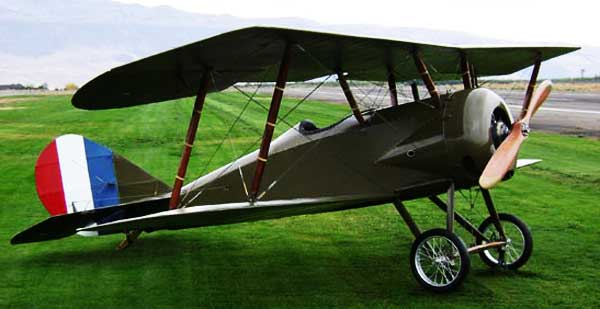
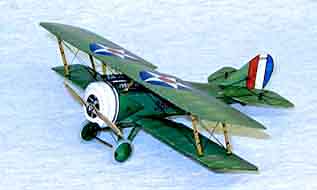 Thomas-Morse S-4 Tommies were used at practically every pursuit flying school in the U.S. during 1918. After the war ended, many were sold as surplus to civilian flying schools, sportsman pilots, and ex-Army fliers.
Thomas-Morse S-4 Tommies were used at practically every pursuit flying school in the U.S. during 1918. After the war ended, many were sold as surplus to civilian flying schools, sportsman pilots, and ex-Army fliers.
Some were still being used in the mid-1930s for WW I aviation movies filmed in Hollywood.
Even to the present time, several Tommies are being flown by aviation buffs in the U.S.
masterpiece.
Thanks for the "sneak preview". David T.Okamura (Jan 20, 01)
From Scott: When Dad showed me this version by Richard Dery and was ready to upload it, all I could say was "Pops, you're doing somthing right. Where did you find this guy?" Over a glass of wine we both agreed that here was someone who could design a Chip Fyn paper model better than Chip Fyn himself. Richard has gone on from there to prove this many times over. (Setember 19th 2020)
When Chip posted that the Tommy was ready for purchase I immediately went to FG and got one. I have always had kind of a love affair with this little bipe. The problem was that it just wasn't one of those subjects that got modeled much. A shame really. It is a wonderful little biplane. Now I can fill up the house with Tommy's. Thanks Chip and Mike. Frank Mooney (Jan 19, 01)
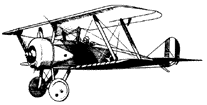 My compliments to Chip and Mike Smith. This model is a winner -- beautiful work! Mike not only captures the essence of this dainty little biplane, but he also got the Fiddlers Green "look and feel" down pat. I look forward to seeing more of Mike's models. You're very fortunate to have such talented designers working with you, Chip. Jim Cookson's X-15 is another mini masterpiece. Thanks for the "sneak preview". David T. Okamura (Jan 20, 01)
My compliments to Chip and Mike Smith. This model is a winner -- beautiful work! Mike not only captures the essence of this dainty little biplane, but he also got the Fiddlers Green "look and feel" down pat. I look forward to seeing more of Mike's models. You're very fortunate to have such talented designers working with you, Chip. Jim Cookson's X-15 is another mini masterpiece. Thanks for the "sneak preview". David T. Okamura (Jan 20, 01)
I'm having some problems with the "Tommy" and I'm hoping you can help me. The assembled Cowl does not fit over the fuselage. Nor is it large enough to fit over the engine. Also, the front ring does not fit into the cowl ring. I thought perhaps it was the way that I printed the model but all the rest of the parts seem to be in proportion. I've printed the model out several times but it still does not come out right. I think this is a wonderful aircraft and I hope you can help me to finish it., John
This is not really a problem...because the cowling is OPEN on the bottom and shouldn't completely encircle the nose.. match the cowling side fairing's up with the gray area in the fuselage and you'll see what we mean. Simple glue into place.
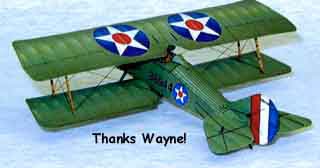
Thomas-Morse S-4 Scout "Tommy"
B. D. Thomas, one of the senior designers of the Curtiss 'Jenny, designed
the S.4 in early 1917. It made its first flight in June, and after evaluation
tests was acquired by the US Army for advanced fighter training. Engine trouble
developed and the original 100-hp Gnome Monosoupape rotary engine was replaced
by an 80-hp Le Rhone. This variant of the plane was known as the S.4C. A total
of 500 planes was ordered, but with the Armistice the last 155 were cancelled.
Only 97 were completed. The performance of the S.4 was superior to that of the
'Jenny', and it became a popular civil trainer after the war. The S.4. also
known familiarly as the 'Tommy' had an illustrious career after the First World
War as a film aircraft, playing British, French and German aircraft with little
more than different paint jobs and tail surfaces. It appeared in Hell's Angels
and Dawn Patrol.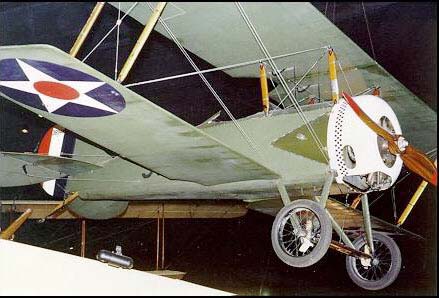
The Thomas company was founded by a young Englishman, W. T. Thomas, who emigrated to the United States and obtained a position with Glenn Curtiss at Hammondsport, New York. He was later joined by his brother Oliver, and they set up the aircraft firm of Thomas Brothers at Hammondsport, where an experimental pusher biplane was constructed in 1910.
The firm then moved to Bath, New York, where a number of types were built; one of these gained the world's altitude record in 1913. Shortly before the outbreak of war in Europe, B. D. Thomas-no relation-joined the concern; he had worked for both the Vickers and Sopwith companies in England. His first design was the T-2 tractor biplane, twenty-four of which were supplied to the British Admiralty in 1915.
After a second move, to Ithaca, New York, the firm began to produce aero engines, one of which was installed in their next design, the D-2 tractor biplane. During 1915 two seaplanes and the D-5 landplane were built for the U.S. Navy and Signal Corps respectively; further seaplanes and a flying boat appeared in the following year.
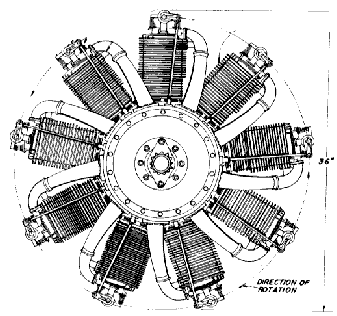 In January 1917 the firm merged with the Morse Chain Company of Ithaca, and
the concern was reorganized as the Thomas-Morse Corporation. The first Thomas-Morse
aeroplane was a trim little single-seater biplane, the S-4. Its 100 h.p. Gnome
Monosoupape 9-B rotary engine was partly enclosed by a circular open-fronted
cowling, which was faired into the flat-sided fuselage by triangular fillets.
In January 1917 the firm merged with the Morse Chain Company of Ithaca, and
the concern was reorganized as the Thomas-Morse Corporation. The first Thomas-Morse
aeroplane was a trim little single-seater biplane, the S-4. Its 100 h.p. Gnome
Monosoupape 9-B rotary engine was partly enclosed by a circular open-fronted
cowling, which was faired into the flat-sided fuselage by triangular fillets.
The staggered wings were constructed of wood, wire-braced and fabric-covered; the top plane was flat, the lower plane had slight dihedral. There was a semicircular cut-out in the trailing-edge of the top wing, which carried the ailerons; these were operated by vertical rods.
Single-bay wooden interplane struts, braced by wire, were fitted; the center section struts were slightly splayed outwards. The fuselage was a wooden wire-braced box girder, with a rounded top decking; the whole structure being covered with fabric.
The neatly shaped empennage was of wood and fabric construction. Wooden vee struts formed the undercarriage legs; the wheels were sprung with rubber cord.
As it could be easily converted into a seaplane, the S-4 was offered to both
the U.S. Army and Navy. The prototype was tested at Hampton, Virginia, and as
a result of these trials fifty modified machines, known as S-4Bs, were ordered
shortly after the United States entered the war.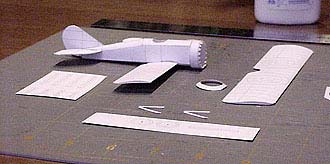
This order was increased to 150 to cope with the increased need for training aeroplanes. Meanwhile a similar model with twin floats, the S-5, was put into production for the Navy Department.
The last fifty machines ordered had shorter-span wings and were designated S-4Cs. Further orders were placed for this version, with the 80 h.p. Le Rhone 9-C rotary, built by the Union Switch and Signal Company of Swissvale, Pennsylvania, in place of the Mono-Gnome; the fuselage of the Le Rhone 'Tommy' was slightly shorter.
In all 447 Le Rhone versions were delivered, and they were widely used as advanced trainers. The final model in the series was the S-4E aerobatic trainer; it had shorter tapered wings and a mounting for a synchronized gun.
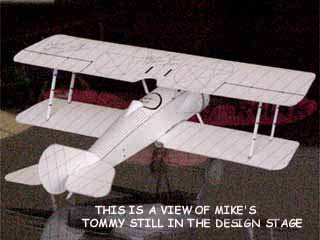
THE THOMAS Morse S~C was a single-seat advanced trainer of which about 600 were built. Most went to the U.S. Army Air Service but a few also went to the U.S. Navy from 1917. They were powered by the 80-hp LeRhone rotary engine and also used the 100-hp Gnome rotary in some models.
Nicknamed "Tommy", the trainer represented to student pursuit pilots all that was to be expected of a single-seat fighter by way of feel and appearance, plus a lot of gentleness that some combat types of WW I lacked. It was not considered good enough, either in performance or handling qualities to be used as a fighter. It never went overseas and was relegated to training fields during WW I.
Over 1,000 were built and, following the Armistice, were declared surplus and purchased by sportsman pilots and barnstormers during the early '20s. The busy roar of its rotary engine that had echoed from dozens of training fields all over the country during the war continued to be heard until about 1930. The motion picture industry used a great many Tommy's after that in Hollywood air epics.
Only one S4B is left, at Cole Palen's Old Rhinebeck Aerodrome; four-C's are in museums.
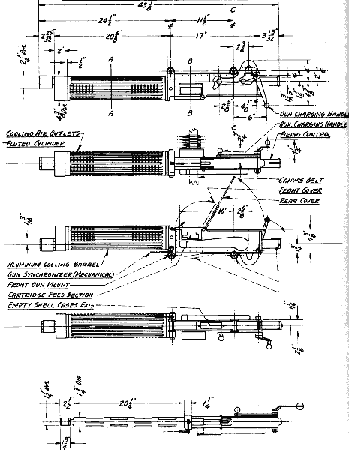
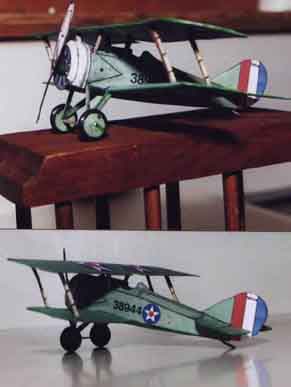
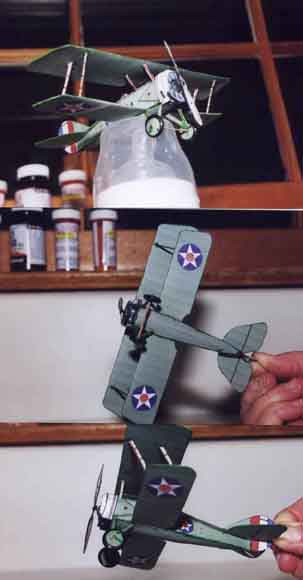
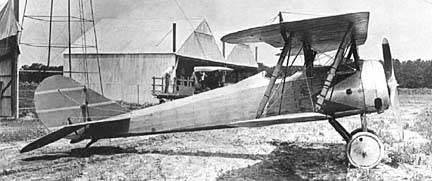

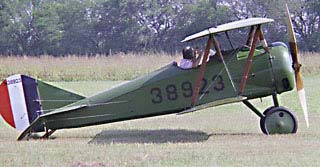
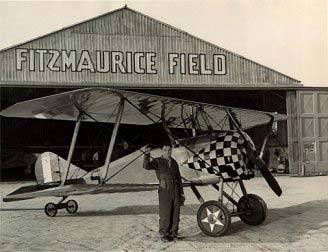

Specifications for the Thomas-Morse S-4c "Tommy"
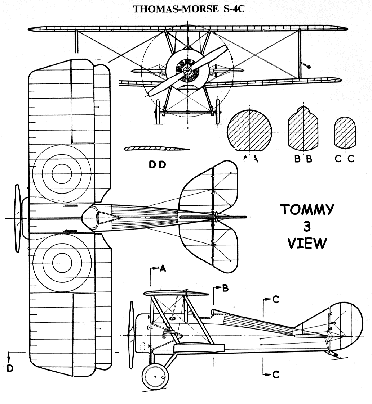 |
Length: 19 ft 10 in Wingspan: 26 ft 6 in Gross weight: 1,330 lb Powerplant: 1 × Le Rhône aircooled rotary, 80 hp Performance Maximum speed: 97 mph Service ceiling: 15,000 ft |
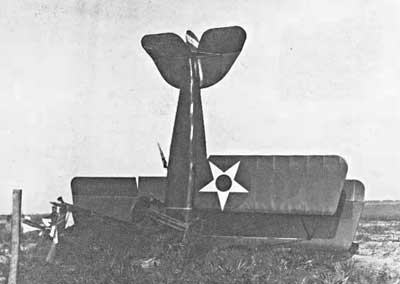 |
| Thomas-Morse S-4c "Tommy" Scout crashed near Carlstrom Field. |


